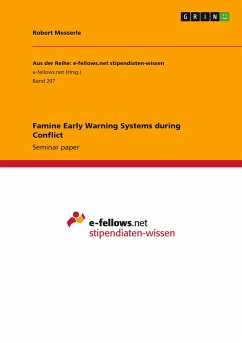Cynthia Grabo
Handbook of Warning Intelligence
Cynthia Grabo
Handbook of Warning Intelligence
- Broschiertes Buch
- Merkliste
- Auf die Merkliste
- Bewerten Bewerten
- Teilen
- Produkt teilen
- Produkterinnerung
- Produkterinnerung
The Handbook was written during the cold war and was classified for 40 years. Originally written as a manual for training intelligence analysts, it explains the fundamentals of intelligence analysis and forecasting, discusses military analysis, as well as the difficulties in u...
Andere Kunden interessierten sich auch für
![Handbook of Warning Intelligence Handbook of Warning Intelligence]() Cynthia GraboHandbook of Warning Intelligence138,99 €
Cynthia GraboHandbook of Warning Intelligence138,99 €![Handbook of Warning Intelligence Handbook of Warning Intelligence]() Cynthia GraboHandbook of Warning Intelligence93,99 €
Cynthia GraboHandbook of Warning Intelligence93,99 €![Handbook of Warning Intelligence Handbook of Warning Intelligence]() Cynthia GraboHandbook of Warning Intelligence130,99 €
Cynthia GraboHandbook of Warning Intelligence130,99 €![Early Warning mechanism in cyber space Early Warning mechanism in cyber space]() Vasile Florin PopescuEarly Warning mechanism in cyber space27,99 €
Vasile Florin PopescuEarly Warning mechanism in cyber space27,99 €![CONFLICT EARLY WARNING AND RESPONSE MECHANISMS IN IGAD SUB-REGION CONFLICT EARLY WARNING AND RESPONSE MECHANISMS IN IGAD SUB-REGION]() WENANI A. KILONG'ICONFLICT EARLY WARNING AND RESPONSE MECHANISMS IN IGAD SUB-REGION33,99 €
WENANI A. KILONG'ICONFLICT EARLY WARNING AND RESPONSE MECHANISMS IN IGAD SUB-REGION33,99 €![The Empire's Warning The Empire's Warning]() John ShentonThe Empire's Warning20,99 €
John ShentonThe Empire's Warning20,99 €![Famine Early Warning Systems during Conflict Famine Early Warning Systems during Conflict]() Robert MesserleFamine Early Warning Systems during Conflict17,95 €
Robert MesserleFamine Early Warning Systems during Conflict17,95 €-
-
-
The Handbook was written during the cold war and was classified for 40 years. Originally written as a manual for training intelligence analysts, it explains the fundamentals of intelligence analysis and forecasting, discusses military analysis, as well as the difficulties in u...
Hinweis: Dieser Artikel kann nur an eine deutsche Lieferadresse ausgeliefert werden.
Hinweis: Dieser Artikel kann nur an eine deutsche Lieferadresse ausgeliefert werden.
Produktdetails
- Produktdetails
- Verlag: Rowman & Littlefield Publishers
- Seitenzahl: 454
- Erscheinungstermin: 9. September 2015
- Englisch
- Abmessung: 229mm x 152mm x 27mm
- Gewicht: 732g
- ISBN-13: 9781442248137
- ISBN-10: 1442248130
- Artikelnr.: 42811948
- Herstellerkennzeichnung
- Libri GmbH
- Europaallee 1
- 36244 Bad Hersfeld
- gpsr@libri.de
- Verlag: Rowman & Littlefield Publishers
- Seitenzahl: 454
- Erscheinungstermin: 9. September 2015
- Englisch
- Abmessung: 229mm x 152mm x 27mm
- Gewicht: 732g
- ISBN-13: 9781442248137
- ISBN-10: 1442248130
- Artikelnr.: 42811948
- Herstellerkennzeichnung
- Libri GmbH
- Europaallee 1
- 36244 Bad Hersfeld
- gpsr@libri.de
Jan Goldman is Professor of Intelligence and National Security Studies at Tiffin University. He has been an analyst and educator in the intelligence and academic communities for over 30 years. He is the founding editor of a series of textbooks for the intelligence profession, Security Professionals Intelligence Education Series-SPIES (Rowman and Littlefield Publishers), and an academic journal focusing on ethics and intelligence. His most recent publications include War on Terror Encyclopedia: From the Rise of Al Qaeda to 9/11 and Beyond, and The Central Intelligence Agency: An Encyclopedia of Covert Operations, Intelligence Gathering, and Spies. He received his doctorate from George Washington University.
Foreword to the new edition Foreword to the previous edition Author's note
to the original edition Part I: Why Warning Intelligence And What Is It?
Some Fundamentals Chapter 1: General Nature of the Problem Chapter 2:
Definitions of Terms and Their Usage Chapter 3: What Warning Is and Is Not
Chapter 4: Warning and Collection Chapter 5: Intentions versus Capabilities
Part II: Organization and Tools of the Trade Chapter 6: Problems of
Organization and Management Chapter 7: Indicator lists Chapter 8: The
Compiling of Indications Chapter 9: Can Computers 'Hel p? Part III:
Introduction to the Analytical Method Chapter 10: Some Fundamentals of
Indications Analysis Chapter 11: Some Specifics of the Analytical Method.
Chapter 12: What Makes a Good Warning Analyst? Part IV: Specific Problems
of Military Analysis Chapter 13: Importance of Military Indications Chapter
14: Order of Bottle Analysis in Crisis Situations Chapter 15: Analysis of
Mobilization Chapter 16: Logistics is the Queen of Battles Chapter 17:
Other Factors in Combat Preparations Chapter 18: Coping with Extraordinary
Military Developments Part V: Specific Problems of Political, Civil and
Economic Analysis Chapter 19: Importance of Political Factors for Warning
Chapter 20: Basic Political Warning -- A Problem of Perception Chapter 21:
Some Specific Factors in Political Warning Chapter 22: Economic Indicators
Chapter 23: Civil Defense Chapter 24: Security, Counter-Intelligence and
Agent Preparations Part VI: Some Major Analytical Problems Chapter 25:
Warning from the Totality of Evidence Chapter 26: The Impact on Warning of
Circumstances Leading to War Chapter 27: Reconstructing the Enemy's
Decision Making Process Chapter 28: Assessing the Timing of Attack Chapter
29: Deception: Can We Cope With It? The following chapters are new to this
edition. Part VII: Problems of Particular Types Of Warfare Chapter 30:
Analysis with Hostilities Already in Progress Chapter 31: Problems Peculiar
to Guerrilla Warfare and "Wars of Liberation" Chapter 32: Hypothetical
Problems of the Coming of World War III Part VIII: Reaching And Reporting
The Warning Judgment Chapter 33: Vital Importance of the Judgment Chapter
34: What Does the Policy Maker Need, and Want to Know? Chapter 35: How to
Write Indications or Warning Items Chapter 36: Assessing Probabilities
Chapter 37: Some Major Factors Influencing Judgments and Reporting Chapter
38: Most Frequent Errors in the Judgment and Reporting Process Part IX:
Conclusions Chapter 39: A Summing Up, With Some Do's and Don'ts for
Analysts and Supervisors About the Authors
to the original edition Part I: Why Warning Intelligence And What Is It?
Some Fundamentals Chapter 1: General Nature of the Problem Chapter 2:
Definitions of Terms and Their Usage Chapter 3: What Warning Is and Is Not
Chapter 4: Warning and Collection Chapter 5: Intentions versus Capabilities
Part II: Organization and Tools of the Trade Chapter 6: Problems of
Organization and Management Chapter 7: Indicator lists Chapter 8: The
Compiling of Indications Chapter 9: Can Computers 'Hel p? Part III:
Introduction to the Analytical Method Chapter 10: Some Fundamentals of
Indications Analysis Chapter 11: Some Specifics of the Analytical Method.
Chapter 12: What Makes a Good Warning Analyst? Part IV: Specific Problems
of Military Analysis Chapter 13: Importance of Military Indications Chapter
14: Order of Bottle Analysis in Crisis Situations Chapter 15: Analysis of
Mobilization Chapter 16: Logistics is the Queen of Battles Chapter 17:
Other Factors in Combat Preparations Chapter 18: Coping with Extraordinary
Military Developments Part V: Specific Problems of Political, Civil and
Economic Analysis Chapter 19: Importance of Political Factors for Warning
Chapter 20: Basic Political Warning -- A Problem of Perception Chapter 21:
Some Specific Factors in Political Warning Chapter 22: Economic Indicators
Chapter 23: Civil Defense Chapter 24: Security, Counter-Intelligence and
Agent Preparations Part VI: Some Major Analytical Problems Chapter 25:
Warning from the Totality of Evidence Chapter 26: The Impact on Warning of
Circumstances Leading to War Chapter 27: Reconstructing the Enemy's
Decision Making Process Chapter 28: Assessing the Timing of Attack Chapter
29: Deception: Can We Cope With It? The following chapters are new to this
edition. Part VII: Problems of Particular Types Of Warfare Chapter 30:
Analysis with Hostilities Already in Progress Chapter 31: Problems Peculiar
to Guerrilla Warfare and "Wars of Liberation" Chapter 32: Hypothetical
Problems of the Coming of World War III Part VIII: Reaching And Reporting
The Warning Judgment Chapter 33: Vital Importance of the Judgment Chapter
34: What Does the Policy Maker Need, and Want to Know? Chapter 35: How to
Write Indications or Warning Items Chapter 36: Assessing Probabilities
Chapter 37: Some Major Factors Influencing Judgments and Reporting Chapter
38: Most Frequent Errors in the Judgment and Reporting Process Part IX:
Conclusions Chapter 39: A Summing Up, With Some Do's and Don'ts for
Analysts and Supervisors About the Authors
Foreword to the new edition Foreword to the previous edition Author's note
to the original edition Part I: Why Warning Intelligence And What Is It?
Some Fundamentals Chapter 1: General Nature of the Problem Chapter 2:
Definitions of Terms and Their Usage Chapter 3: What Warning Is and Is Not
Chapter 4: Warning and Collection Chapter 5: Intentions versus Capabilities
Part II: Organization and Tools of the Trade Chapter 6: Problems of
Organization and Management Chapter 7: Indicator lists Chapter 8: The
Compiling of Indications Chapter 9: Can Computers 'Hel p? Part III:
Introduction to the Analytical Method Chapter 10: Some Fundamentals of
Indications Analysis Chapter 11: Some Specifics of the Analytical Method.
Chapter 12: What Makes a Good Warning Analyst? Part IV: Specific Problems
of Military Analysis Chapter 13: Importance of Military Indications Chapter
14: Order of Bottle Analysis in Crisis Situations Chapter 15: Analysis of
Mobilization Chapter 16: Logistics is the Queen of Battles Chapter 17:
Other Factors in Combat Preparations Chapter 18: Coping with Extraordinary
Military Developments Part V: Specific Problems of Political, Civil and
Economic Analysis Chapter 19: Importance of Political Factors for Warning
Chapter 20: Basic Political Warning -- A Problem of Perception Chapter 21:
Some Specific Factors in Political Warning Chapter 22: Economic Indicators
Chapter 23: Civil Defense Chapter 24: Security, Counter-Intelligence and
Agent Preparations Part VI: Some Major Analytical Problems Chapter 25:
Warning from the Totality of Evidence Chapter 26: The Impact on Warning of
Circumstances Leading to War Chapter 27: Reconstructing the Enemy's
Decision Making Process Chapter 28: Assessing the Timing of Attack Chapter
29: Deception: Can We Cope With It? The following chapters are new to this
edition. Part VII: Problems of Particular Types Of Warfare Chapter 30:
Analysis with Hostilities Already in Progress Chapter 31: Problems Peculiar
to Guerrilla Warfare and "Wars of Liberation" Chapter 32: Hypothetical
Problems of the Coming of World War III Part VIII: Reaching And Reporting
The Warning Judgment Chapter 33: Vital Importance of the Judgment Chapter
34: What Does the Policy Maker Need, and Want to Know? Chapter 35: How to
Write Indications or Warning Items Chapter 36: Assessing Probabilities
Chapter 37: Some Major Factors Influencing Judgments and Reporting Chapter
38: Most Frequent Errors in the Judgment and Reporting Process Part IX:
Conclusions Chapter 39: A Summing Up, With Some Do's and Don'ts for
Analysts and Supervisors About the Authors
to the original edition Part I: Why Warning Intelligence And What Is It?
Some Fundamentals Chapter 1: General Nature of the Problem Chapter 2:
Definitions of Terms and Their Usage Chapter 3: What Warning Is and Is Not
Chapter 4: Warning and Collection Chapter 5: Intentions versus Capabilities
Part II: Organization and Tools of the Trade Chapter 6: Problems of
Organization and Management Chapter 7: Indicator lists Chapter 8: The
Compiling of Indications Chapter 9: Can Computers 'Hel p? Part III:
Introduction to the Analytical Method Chapter 10: Some Fundamentals of
Indications Analysis Chapter 11: Some Specifics of the Analytical Method.
Chapter 12: What Makes a Good Warning Analyst? Part IV: Specific Problems
of Military Analysis Chapter 13: Importance of Military Indications Chapter
14: Order of Bottle Analysis in Crisis Situations Chapter 15: Analysis of
Mobilization Chapter 16: Logistics is the Queen of Battles Chapter 17:
Other Factors in Combat Preparations Chapter 18: Coping with Extraordinary
Military Developments Part V: Specific Problems of Political, Civil and
Economic Analysis Chapter 19: Importance of Political Factors for Warning
Chapter 20: Basic Political Warning -- A Problem of Perception Chapter 21:
Some Specific Factors in Political Warning Chapter 22: Economic Indicators
Chapter 23: Civil Defense Chapter 24: Security, Counter-Intelligence and
Agent Preparations Part VI: Some Major Analytical Problems Chapter 25:
Warning from the Totality of Evidence Chapter 26: The Impact on Warning of
Circumstances Leading to War Chapter 27: Reconstructing the Enemy's
Decision Making Process Chapter 28: Assessing the Timing of Attack Chapter
29: Deception: Can We Cope With It? The following chapters are new to this
edition. Part VII: Problems of Particular Types Of Warfare Chapter 30:
Analysis with Hostilities Already in Progress Chapter 31: Problems Peculiar
to Guerrilla Warfare and "Wars of Liberation" Chapter 32: Hypothetical
Problems of the Coming of World War III Part VIII: Reaching And Reporting
The Warning Judgment Chapter 33: Vital Importance of the Judgment Chapter
34: What Does the Policy Maker Need, and Want to Know? Chapter 35: How to
Write Indications or Warning Items Chapter 36: Assessing Probabilities
Chapter 37: Some Major Factors Influencing Judgments and Reporting Chapter
38: Most Frequent Errors in the Judgment and Reporting Process Part IX:
Conclusions Chapter 39: A Summing Up, With Some Do's and Don'ts for
Analysts and Supervisors About the Authors








